The Monkey Head Nebula is an emission nebula located approximately 6,400 light-years away in the equatorial constellation Orion. The nebula has an apparent magnitude of 6.8 and an apparent size of 40 arcseconds. It is listed as NGC 2174 in the New General Catalogue.
The Monkey Head Nebula is an H II region, a large cloud of ionized gas in which new stars are forming. The cloud is a site of intense star formation. It is associated with the open cluster NGC 2175.
The stellar nursery contains many young stars that are embedded within the surrounding dust and gas. These stars emit intense ultraviolet radiation which ionizes the hydrogen gas, making the nebula glow at infrared wavelengths.
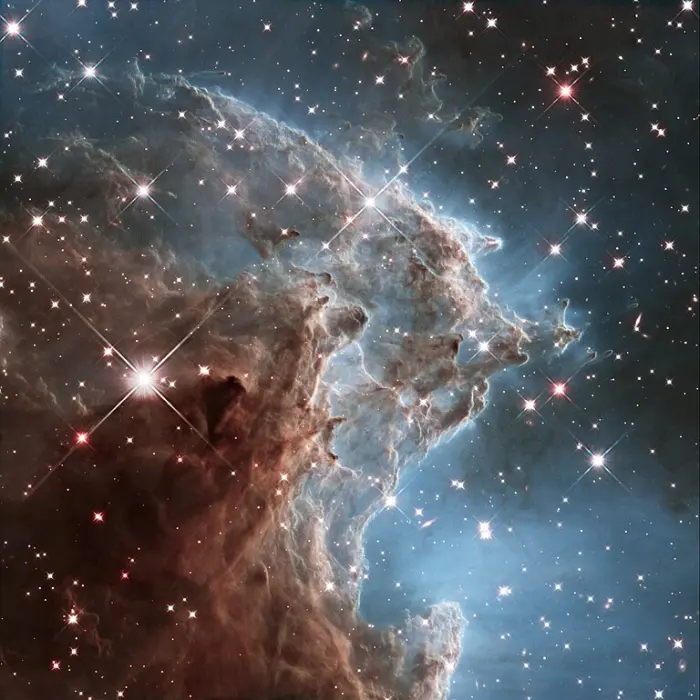
To celebrate its 24th year in orbit, the NASA/ESA Hubble Space Telescope has released this beautiful new image of part of NGC 2174, also known as the Monkey Head Nebula. NGC 2174 lies about 6400 light-years away in the constellation of Orion (The Hunter). Hubble previously viewed this part of the sky back in 2011 — the colourful region is filled with young stars embedded within bright wisps of cosmic gas and dust. This portion of the Monkey Head Nebula was imaged in the infrared using Hubble’s Wide Field Camera 3. Image: NASA, ESA, and the Hubble Heritage Team (STScI/AURA) (CC BY 4.0)
NGC 2174 was nicknamed the Monkey Head Nebula because some of its clouds resemble the face of a monkey when seen in visible light.
The massive, young O-type star HD 42088 is the main source of energy in NGC 2174. It lies near the centre of the nebula. With an effective temperature of 39,500 K, the star shines with a luminosity of 8,200 Suns.
HD 42088 is a supernova candidate. It has a mass between 15 and 32 times that of the Sun. With an apparent magnitude of 7.56, the young star is invisible to the unaided eye.
The ultraviolet light and strong stellar winds generated by the newly formed stars near the nebula’s centre sculpt the nebula’s dust and gas into various shapes. The light and winds from the infant stars are dispersing the clouds in which the stars were formed. The dust clouds that are silhouetted against the glowing nebulosity give the Monkey Head Nebula a complex appearance.
The Monkey Head Nebula surrounds several loose clusters of young stars. It will evaporate and disappear into the surrounding space within the next few million years.
Infrared observations of NGC 2174 with the Spitzer Space Telescope have revealed patches of light that contain infant stars that will form new star clusters over the next few thousands of years. These stars will eventually erode the surrounding gas clouds and pillars of dust, removing the material necessary for further star formation in the region.
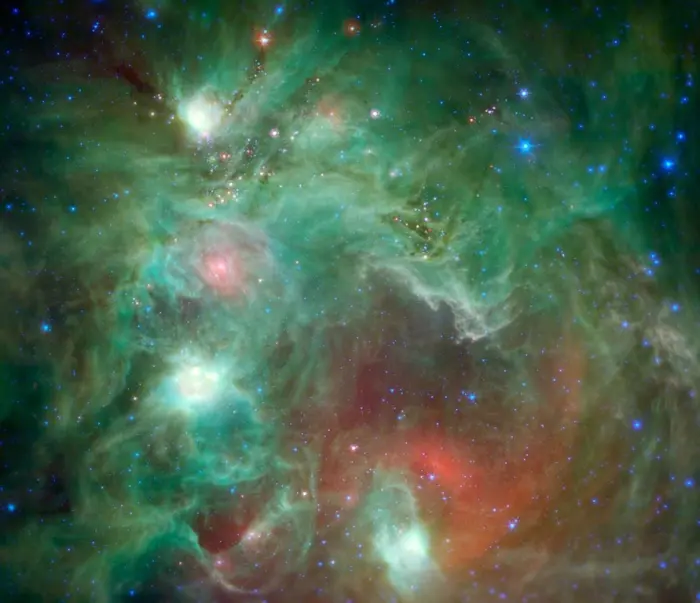
Scores of baby stars shrouded by dust are revealed in this infrared image of the star-forming region NGC 2174, as seen by NASA’s Spitzer Space Telescope. Some of the clouds in the region resemble the face of a monkey in visible-light images, hence the nebula’s nickname: the “Monkey Head.” However, in infrared images such as this, the monkey disappears. That’s because different clouds are highlighted in infrared and visible-light images. Found in the northern reaches of the constellation Orion, NGC 2174 is located around 6,400 light-years away. Columns of dust, slightly to the right of center in the image, are being carved out of the dust by radiation and stellar winds from the hottest young stars recently born in the area. Spitzer’s infrared view provides us with a preview of the next clusters of stars that will be born in the coming millennia. The reddish spots of light scattered through the darker filaments are infant stars swaddled by blankets of warm dust. The warm dust glows brightly at infrared wavelengths. Eventually, these stars will pop out of their dusty envelopes and their light will carve away at the dust clouds surrounding them. In this image, infrared wavelengths have been assigned visible colors we see with our eyes. Light with a wavelength of 3.5 microns is shown in blue, 8.0 microns is green, and 24 microns in red. The greens show the organic molecules in the dust clouds, illuminated by starlight. Reds are caused by the thermal radiation emitted from the very hottest areas of dust. Image: NASA/JPL-Caltech (PD)
With an apparent size of 40 arcminutes, NGC 2174 appears larger than the full Moon. However, the details of the nebula are only visible in larger telescopes.
The open cluster NGC 2175 has an apparent magnitude of 6.8 and lies approximately 6,350 light-years away. It has an apparent size of 18 arcminutes.
The Monkey Head Nebula contains the radio source 3C 153.1. Discovered by Wyndham in 1966, the radio source lies within the bright knot of NGC 2174. The knot is 1 by 2 arcminutes across and appears around 3 degrees east of the star HD 42088.
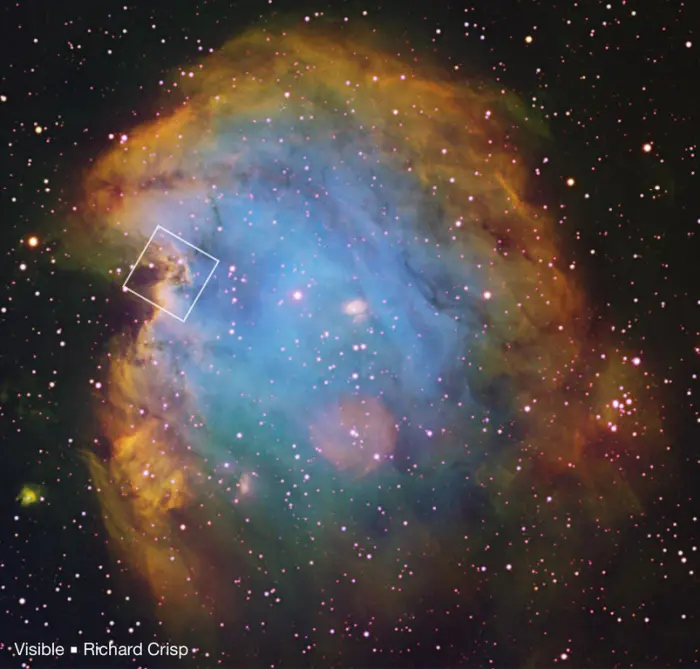
This image shows the region of NGC 2174, taken in infrared and released for Hubble’s 24th birthday, in its wider context. On the left is a ground based image taken by an amateur astrophotographer of the star-forming nebula in visible light, with an outline showing the area of the detailed Hubble image. On the right is a small detail of a star-forming column in the nebula, made by Hubble’s WFC3 infrared camera. Credit: NASA and ESA Acknowledgment: NASA, ESA, and the Hubble Heritage Team (STScI/AURA), and R. Crisp (CC BY 3.0)
Facts
The Monkey Head Nebula was discovered by the French astronomer Édouard Stephan on February 6, 1877. Stephan spotted the nebula with an 80-cm reflector at the Observatoire de Marseille.
German astronomer Karl Christian Bruhns is usually credited for the discovery of the open star cluster NGC 2175. Bruhns observed the cluster in 1857. However, the cluster may have been spotted by the Italian astronomer Giovanni Batista Hodierna before 1654.
The diffuse nebula that surrounds the cluster NGC 2175 is catalogued as Sh2-252 in the Sharpless catalogue.
The catalogue designations NGC 2174 and NGC 2175 are used differently by different sources. They may refer either to the entire nebula, to the nebula’s brightest knot, or to the open cluster associated with the nebula.
The NGC/IC Project assigns the designation NGC 2174 to the most prominent knot in the nebula and NGC 2175 to the whole nebula and the star cluster. In the SIMBAD astronomical database, the identifier NGC 2174 applies to the nebula and NGC 2175 to the open cluster.
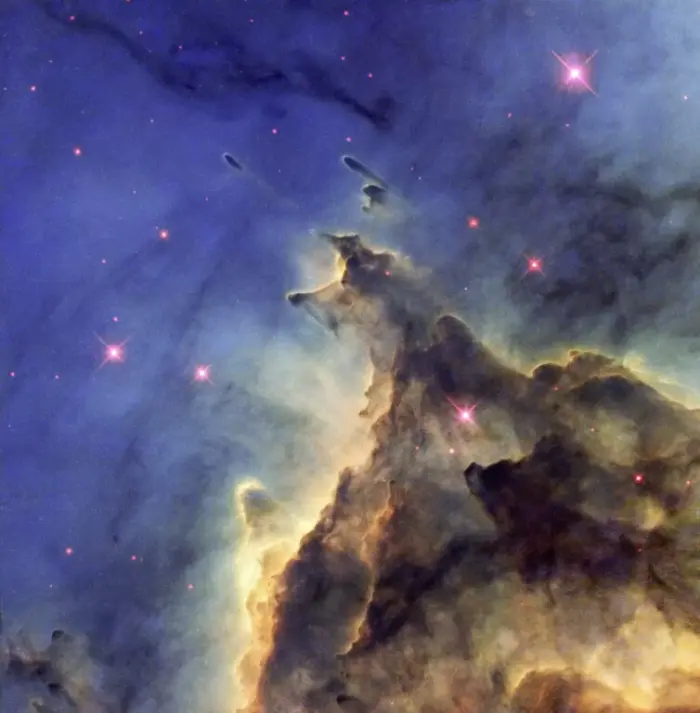
The NASA/ESA Hubble Space Telescope has imaged a stellar nursery called NGC 2174, in which stars are born in a first-come-first-served feeding frenzy for survival. The problem is that star formation is a very inefficient process; most of the ingredients to make stars are wasted as the cloud of gas and dust, or nebula, gradually disperses. In NGC 2174, the rate at which the nebula disperses is further speeded up by the presence of hot young stars, which create high velocity winds that blow the gas outwards. These fiery youngsters also flood the surrounding gas with intense radiation, making it glow brightly, creating the brilliant scene captured here. The nebula is mostly composed of hydrogen gas, which is ionised by the ultraviolet radiation emitted by the hot stars, leading to the nebula’s alternative title as an HII region. This picture shows only part of the nebula, where dark dust clouds are strikingly silhouetted against the glowing gas. NGC 2174 lies about 6400 light-years away in the constellation of Orion (The Hunter). It is not part of the much more familiar Orion Nebula, which lies much closer to us. Despite its prime position in a very familiar constellation this nebula is faint and had to wait until 1877 for its discovery by the French astronomer Jean Marie Edouard Stephan using an 80 cm reflecting telescope at the Observatoire de Marseille. This picture was created from images from the Wide Field Planetary Camera 2 on Hubble. Images through four different filters were combined to make the view shown here. Images through a filter isolating the glow from ionised oxygen (F502N) were coloured blue and images through a filter showing glowing hydrogen (F656N) are green. Glowing ionised sulphur (F673N) and the view through a near-infrared filter (F814W) are both coloured red. The total exposure times per filter were 2600 s, 2600 s, 2600 s and 1000 s respectively and the field of view is about 1.8 arcminutes across. Image credit: ESA/Hubble & NASA (PD)
Location
The Monkey Head Nebula lies in the northern part of the constellation Orion (the Hunter), near the border with Gemini (the Twins). It appears near the tip of Orion’s upraised club, marked by the stars Chi1 and Chi2 Orionis.
Chi1 and Chi2 Orionis appear in the region between the bright star Alhena (Gamma Geminorum) in Gemini and Tianguan (Zeta Tauri) at the southern horn of the Bull (Taurus).
The Monkey Head Nebula lies near the imaginary line connecting Alhena in Gemini and Elnath (Beta Tauri) at the Bull’s northern horn. It can be found near Propus (Eta Geminorum), in the direction of Betelgeuse (Alpha Orionis) in Orion.
The Monkey Head lies in the same region of the sky as the supernova remnant IC 443, better known as the Jellyfish Nebula, in Gemini.
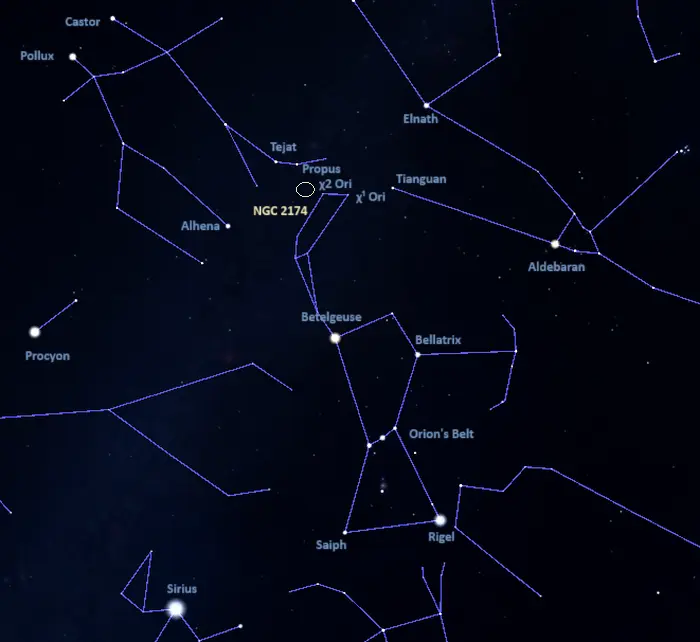
The location of the Monkey Head Nebula (NGC 2174), image: Stellarium
At declination +20°, NGC 2174 is visible from virtually anywhere for at least part of the year. The best time of the year to observe the deep sky objects in Orion is during the month of January, when the celestial Hunter appears higher above the horizon around 9 pm.
Monkey Head Nebula – NGC 2174
| Constellation | Orion |
| Object type | Emission nebula |
| Right ascension | 06h 09.7m |
| Declination | +20° 30′ |
| Apparent magnitude | 6.8 |
| Apparent size | 40’ |
| Distance | 6,400 light-years (2,000 parsecs) |
| Names and designations | Monkey Head Nebula, NGC 2174, Sh2-252 |
Images
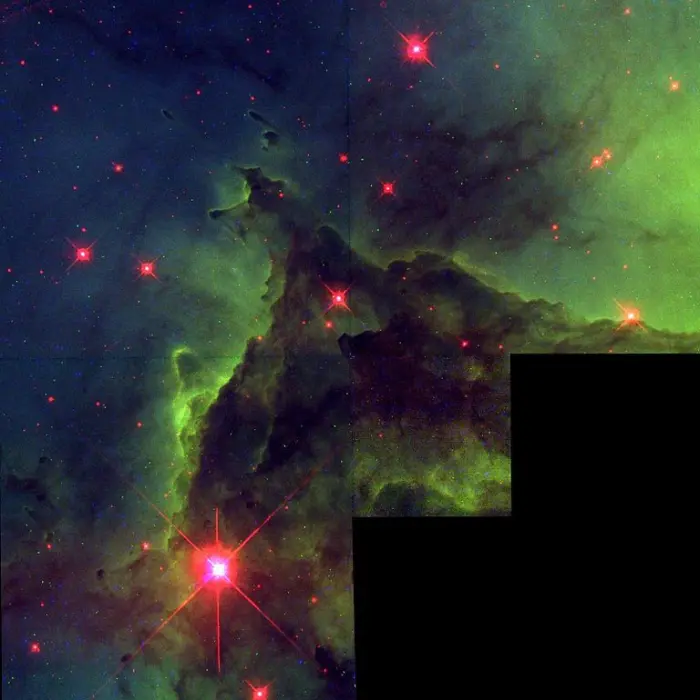
Monkey Head Nebula by the Hubble Space Telescope, credit: NASA/ESA (PD)
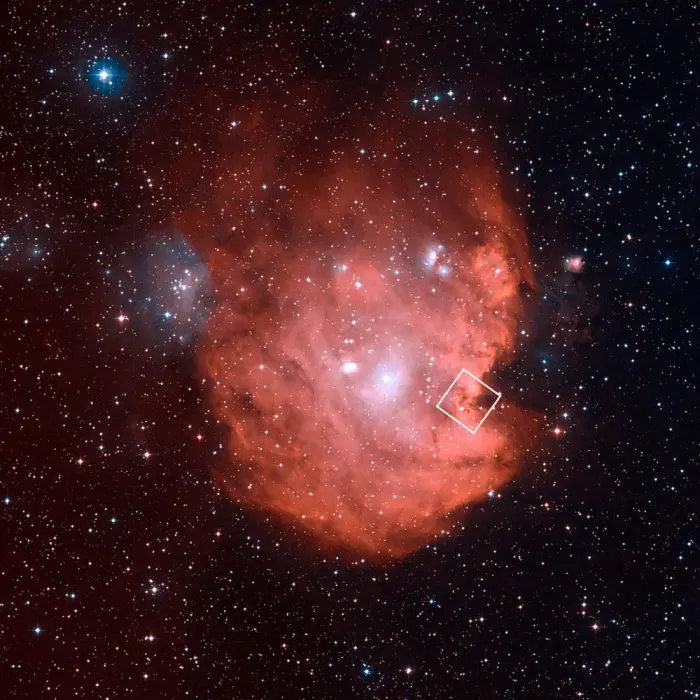
This image, a composite of red and blue exposures from the Digitized Sky Survey 2, shows the region of sky surrounding NGC 2174, more popularly known as the Monkey Head Nebula. To celebrate its 24th year observing Hubble revisited the Monkey Head Nebula and a brand new image was released of one of its breathtaking pillars. The small square near the centre of this image is where the pillar can be found. Image: NASA, ESA, Digitized Sky Survey (DSS), STScI/AURA, Palomar/Caltech (CC BY 4.0)
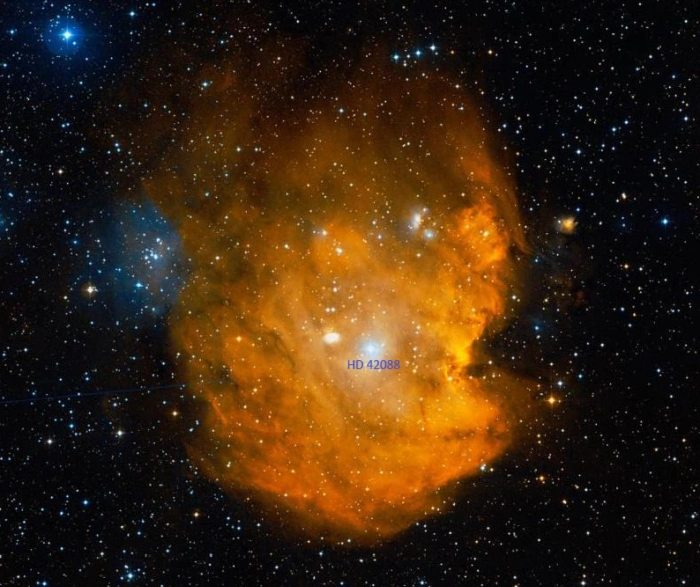
HD 42088 in the Monkey Head Nebula, image credit: ESO/Digitized Sky Survey 2 (CC BY 4.0)